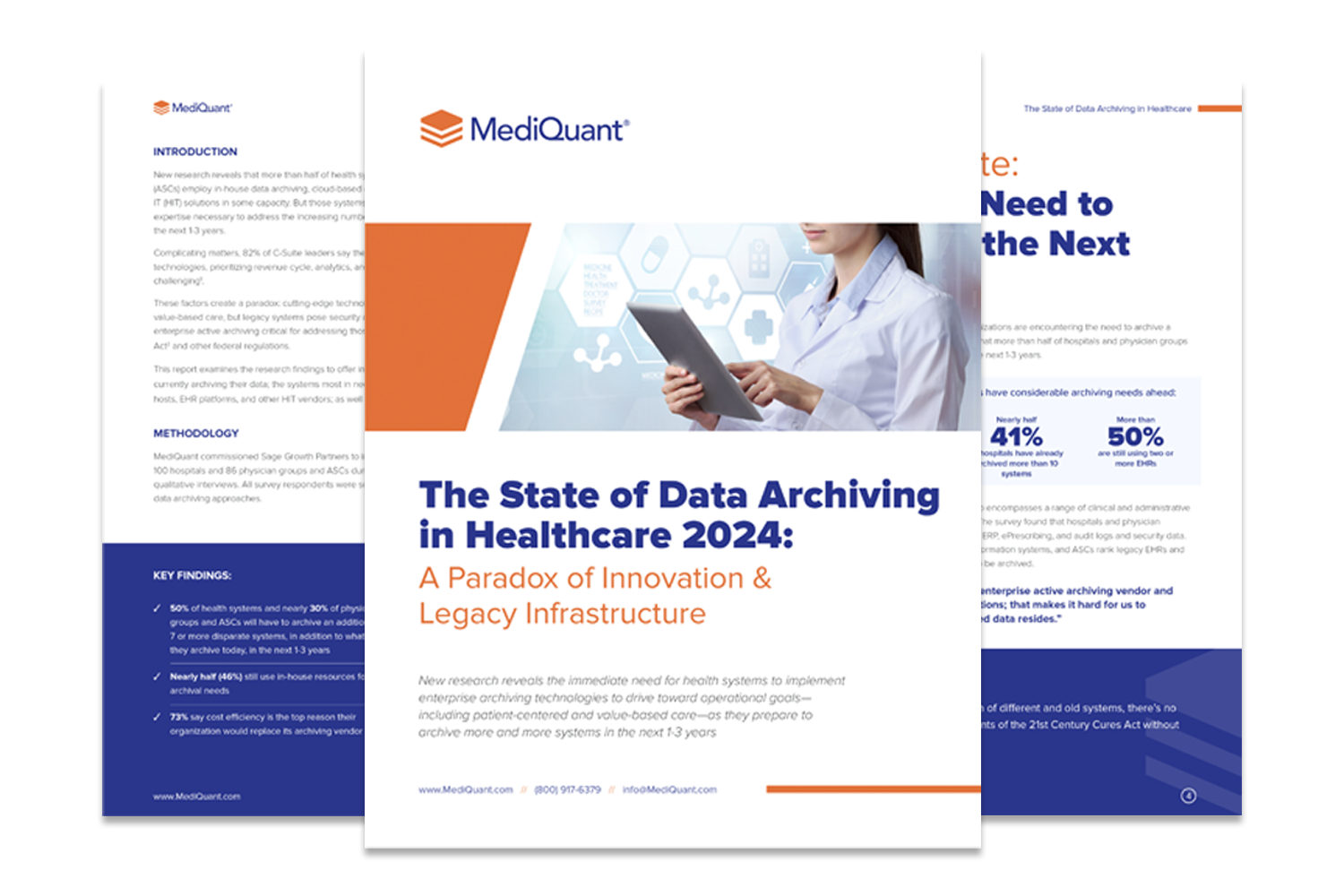Healthcare organizations continue to create and collect data at an unprecedented rate. At the same time, the industry has experienced a record number of mergers. Healthcare services saw more than 1,200 deals in 2019 — the second year in a row. Excluding megadeals, total deal value increased by 77% during 2018 and 2019.
Pairing rapidly increasing data volume with ongoing M&A activity presents unique challenges for healthcare organizations. For example, a patient may have visited two separate organizations in the past, but after a merger, the newly formed entity now needs the ability to provide clinicians with a complete view of that patient’s history – which may not have transferred to the go-forward electronic medical record.
Selecting the right data archiving solution is critical to your being able to provide your organization’s clinicians and staff access to the legacy data they need when they need it. As you consider legacy data archiving solutions, it’s helpful to understand the various options available and the differences between archiving discrete and non-discrete data.
What is non-discrete data archiving?
Non-discrete data includes file types such as PDFs and images. The data inside these documents can’t be extracted or pulled into reports. If you want to access a specific piece of data, you need to review the entire document.
Why Use Non-Discrete Data?
Non-discrete data archiving is less expensive compared to other options; however, it comes with limitations. Analytics and reporting aren’t possible with this option, which poses some potential challenges. With non-discrete data archiving, specific values from a lab report will be buried in a 100-page PDF. As a result, a clinician who needs access to that lab report must scan through dozens of pages to find the relevant value.
Limitations of Non-Discrete Data
Non-discrete data archiving doesn’t support the ability to pull only the relevant data to fulfill release of information (ROI) requests. Instead, you must release entire reports and documents, making this archiving approach less-than ideal for litigation cases. Validation and implementation processes are also more work intensive and time consuming resulting in longer timelines for implementation.
What is Healthcare Discrete Data Archiving?
Discrete data is collected and stored in a database table with a high level of detail. This type of data is both measurable and reportable.
Why Use Discrete Data in Healthcare?
Healthcare IT Skills explains how discrete data is used to pull critical details about medications. In the example, a table includes dosage instructions for an acid reflux medication and illustrates the limitations of capturing dosage information – “1 20mg tablet twice daily for three days” – a single field. If you needed to pull data into a report to find all instances of that specific medication given over a specific period of time, you’d have to manually parse out the individual pieces of data.
Capturing the same data discretely stores the data in individual fields which can be queried for specific pieces of information. If you want to know all instances of strength, duration or any other element, you can run a report to pull those values.
Other examples of discrete data usage include a provider looking for specific data from a lab report captured on a certain day and population health researchers seeking to determine whether a specific geographical area in the country has a higher prevalence of Lyme disease.
A discrete data archiving approach is also useful for gathering details around medical recalls. For example, to figure out how many patients were prescribed a recently recalled medication, or how many patients received an artificial hip and later had complications. Discrete data archiving also allows HIM staff to release only the data relevant to ROI requests.
In the context of legal inquiries, you can better understand the “big picture” of everything involved with a specific patient’s scenario with discrete data archiving. A nurse, for example, may not log data until a few hours after care took place. Capturing discrete data allows full visibility into the timeline of activities outside of manual logging.
Important questions can be answered, such as “Did a patient with heart issues receive treatment after the preliminary result or after the final result?”
Being able to access a full view of a patient’s health history empowers clinicans to make more informed care decisions.
Drawbacks of Discrete Data
The data extraction, organization, validation and implementation processes to support this archiving approach require a greater level of complexity than nondiscrete data archiving and, therefore, it’s more expensive. However, when weighed against the benefits, the increased cost may be considered nominal.
Which Data Archiving Solution is Right For You?
The right archiving solution can help you gain valuable insights and comply with data retention requirements. Here are a few tips to help you evaluate your options:
Examine use cases.
Gather use cases for your data archive. Do you need the ability to extract data? Run analytics? What do you need to do with the data?
Consider retention policies.
What are your retention policies? Get legal and compliance personnel to the table before finalizing your decision.
Determine file types.
Do you have a small organization that archives only images and PDFs? Or, is your organization large, with vast amounts of data that need to be readily accessed?
Your Healthcare Data Archiving Solution
Decommissioning legacy applications is a significant undertaking, but it’s one that stands to save health systems hundreds of thousands of dollars by eliminating maintenance and licensing fees. If you need assistance determining which archiving solution is best for your organization, we can help. MediQuant assists healthcare organizations with solutions that support more informed clinical decisions and improve the patient, provider and clinician experience.
We partner with our customers throughout the data archiving process, mapping and loading your full set of data into your new archive solution, validating its accuracy, and establishing interfaces and integrations to meet your archiving needs.
For more information, visit MediQuant.com today


